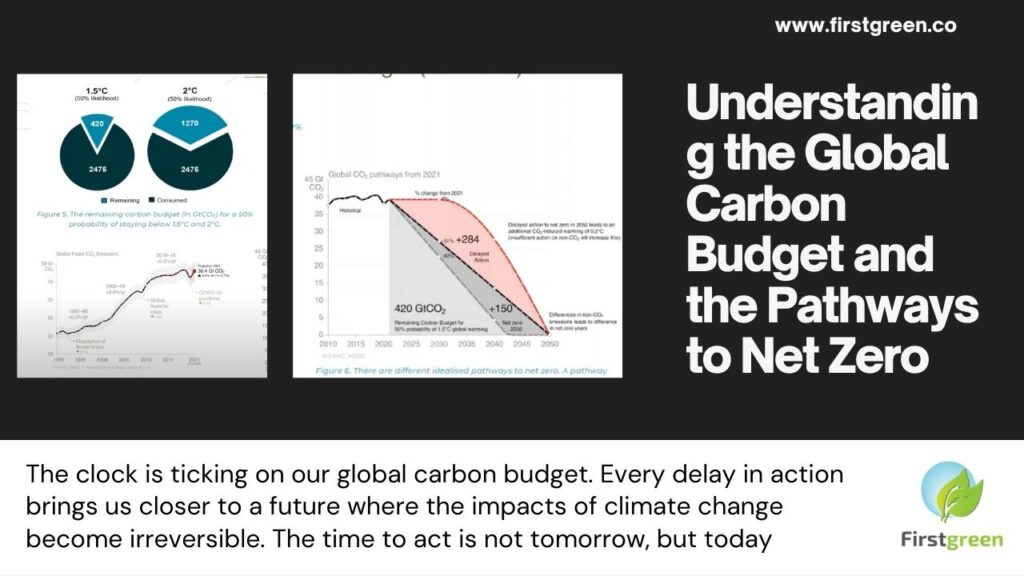Understanding the Global Carbon Budget and the Pathways to Net Zero

In the ongoing battle against climate change, understanding the global carbon budget is crucial. The carbon budget represents the maximum amount of carbon dioxide (CO₂) that can be emitted while still having a good chance of limiting global temperature rise to a certain level. The data presented here offers a stark reminder of the challenges we face in achieving these targets, specifically the 1.5°C and 2°C global warming limits.
The Carbon Budget and Pathways to Net Zero
The first figure highlights two potential pathways to reach net-zero emissions by 2050. The gray line shows a scenario where immediate action is taken to reduce emissions, while the red line illustrates a delayed action scenario. Both pathways eventually lead to net-zero emissions by 2050, but the consequences of delayed action are significant.
If action is delayed, cumulative CO₂ emissions will reach 420 GtCO₂, which corresponds to a 50% probability of keeping global warming below 1.5°C. However, the delayed action scenario results in an additional 284 GtCO₂ emitted, leading to a higher likelihood of exceeding the 1.5°C limit. This additional warming, by 0.2°C, could have severe consequences, as it increases the risk of more frequent and severe climate impacts.
The gray pathway, which takes immediate action, remains within the 420 GtCO₂ limit, providing a better chance of keeping warming under control. This scenario emphasizes the importance of urgent and sustained efforts to reduce emissions.
Remaining Carbon Budgets for 1.5°C and 2°C Targets
The second figure presents the remaining carbon budgets for the 1.5°C and 2°C global warming limits. The 1.5°C target has a remaining budget of 420 GtCO₂ out of an original budget of 2,475 GtCO₂. In contrast, the 2°C target allows for a larger remaining budget of 1,270 GtCO₂.
This comparison highlights the limited room we have left to maneuver if we are to meet the more ambitious 1.5°C target. The larger budget associated with the 2°C target may seem more achievable, but it also comes with increased risks of severe climate impacts, such as more extreme weather events, sea-level rise, and biodiversity loss.
Historical Context and Future Projections
The third figure shows the trajectory of global fossil CO₂ emissions from 1990 to 2021. Over the years, emissions have increased steadily, with notable dips during global events like the financial crisis of 2008 and the COVID-19 pandemic. Despite these temporary reductions, emissions have rebounded quickly, and as of 2021, they are projected to reach 36.4 GtCO₂.
This historical context underscores the difficulty of curbing CO₂ emissions and the resilience of fossil fuel dependency in the global economy. The trendline based on data from 2010 to 2019 suggests that, without significant changes, emissions will continue to rise, making it even more challenging to stay within the carbon budget.
The Urgency of Immediate Action
The data presented here paints a clear picture: the longer we delay action on reducing CO₂ emissions, the more difficult it becomes to meet our climate goals. The delayed action scenario results in a significant overshoot of the carbon budget, leading to higher global temperatures and increased climate risks.
Immediate action is not just preferable; it is necessary. To stay within the 420 GtCO₂ budget and have a 50% chance of keeping global warming below 1.5°C, we must drastically reduce our emissions now. This will require a concerted global effort, with policies that promote renewable energy, energy efficiency, and carbon capture technologies, along with significant changes in consumption patterns and lifestyle choices.
In conclusion, the global carbon budget serves as a crucial guide for policymakers and society as a whole. It underscores the importance of immediate and sustained action to mitigate the worst effects of climate change. Delaying action only increases the risks and costs associated with climate change, making it imperative that we act now to secure a safer, more sustainable future.